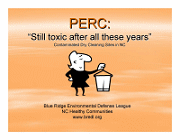|
ACTION ALERT
To everyone in North Carolina concerned about our future!
Sign-on Letter
The North Carolina Environmental Management Commission is about
to carve a loophole in North Carolina environmental law. Approval
of a pending rule would create an exception for special interests
now and a precedent for more exemptions in the future.
Is there a dry-cleaning business in your community? The
dry-cleaning industry and their supporters have drafted a new
rule which would leave excessive amounts of toxic solvents in the
soil and groundwater, not only at hundreds of commercial
dry-cleaning sites but on neighboring property, too. Why? They
want to reduce their clean-up costs. We think polluters should
abide by existing laws which require groundwater to be safe
enough to drink, the highest standard for public health
protection.
We can stop the erosion of public health
protection and the chipping away of environmental laws. Please
add your name and organizational affiliation to our letter to be
delivered to the North Carolina Environmental Management
Commission, the state's rule-making body. Help us stop a proposed
rule change which would allow contaminated dry-cleaning sites to
remain polluted.
We want to have as many people as possible sign on before the
upcoming meeting of the NC Environmental Management Commission on
July 12. So feel free to pass the word. People should sign on by
sending their name and address to BREDL@skybest.com. With
enough people from enough areas of the state, we can convince the
Commission to heed our request. We will hand deliver it to the
EMC at 9:00 AM Thursday, July 12, 2007.
Sign-on Letter
According to the Dry-cleaning Solvent Cleanup Act Program’s
2006 Annual Report to the General Assembly, the state has
identified 225 operating or abandoned dry-cleaning facilities in
46 counties with environmental contamination caused by
dry-cleaning solvent. A total of 29 new dry-cleaning solvent
releases were reported to in 2005. There are approximately 700
operating retail dry-cleaning establishments in North Carolina
today. As many as 1,500 contaminated dry-cleaning sites may exist
in North Carolina.
|



